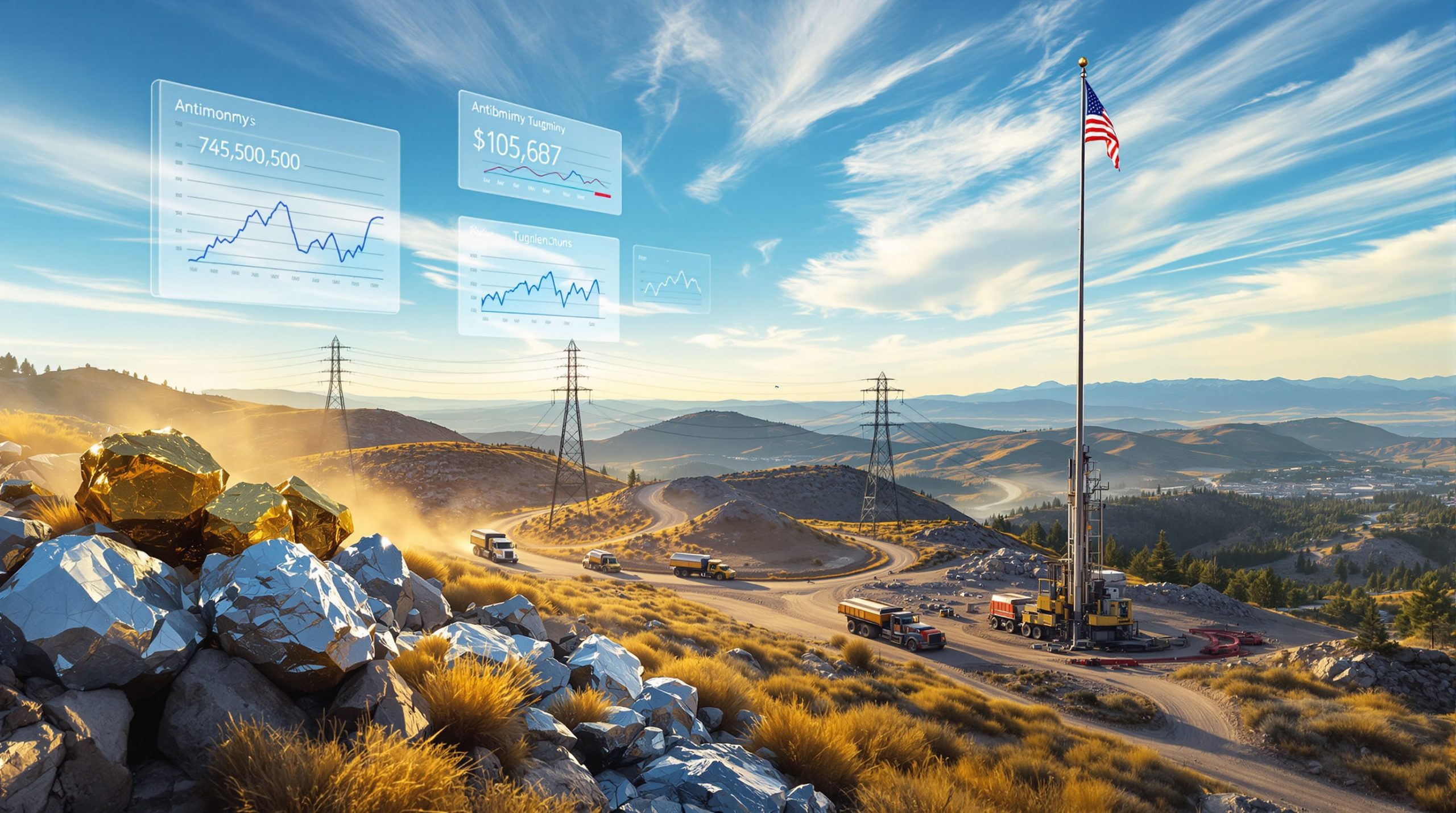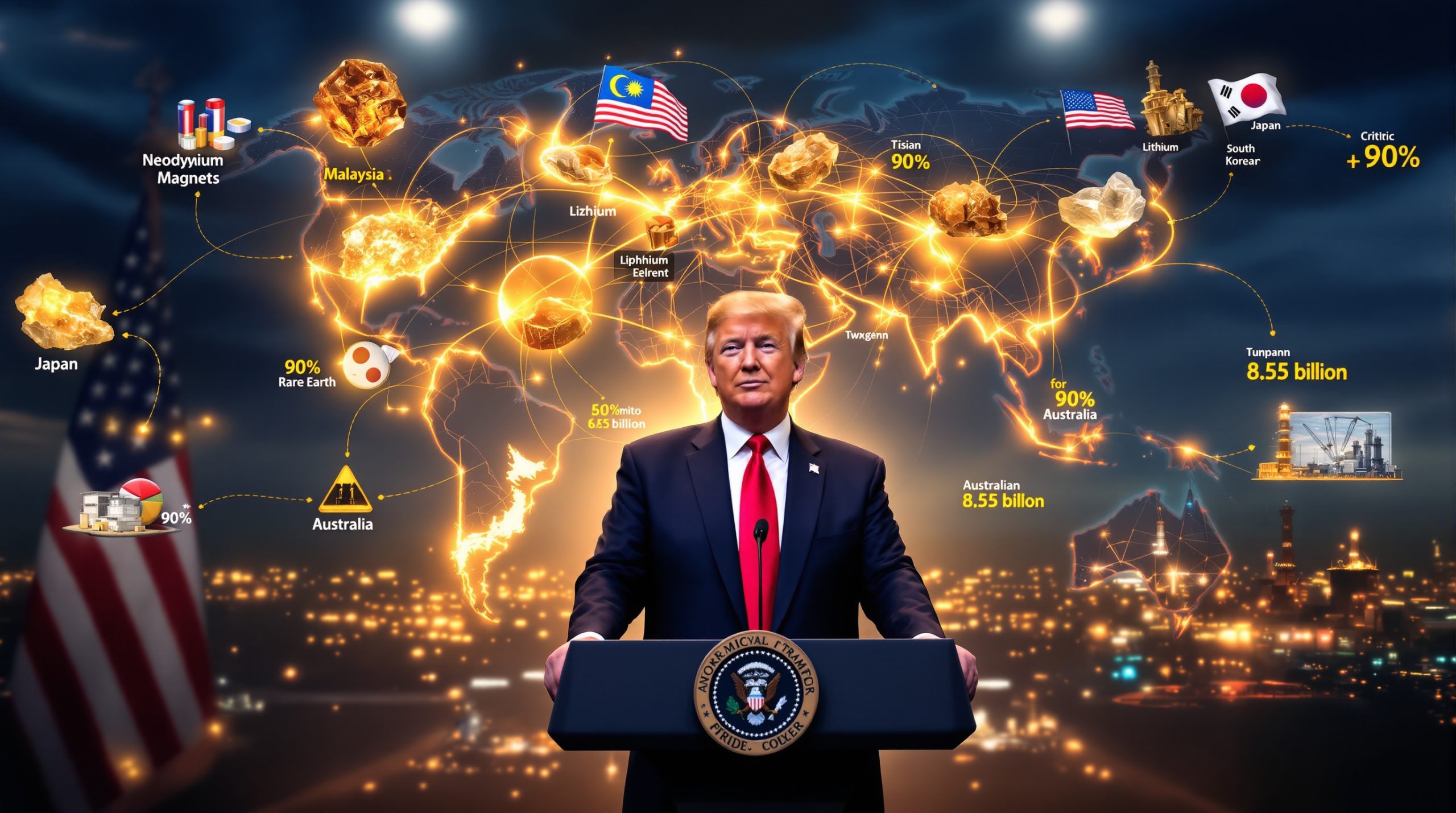What Are Critical Minerals and Why Do They Matter?
Critical minerals represent a strategic subset of elements essential for modern technology and global security. While the term may seem academic, these resources form the backbone of our technological future and are increasingly at the center of international geopolitical tensions.
Understanding Critical Minerals vs. Rare Earths
Critical minerals include lithium, nickel, cobalt, and copper – essential elements for battery development and renewable energy infrastructure. These minerals power everything from smartphones to electric vehicles and are fundamental to the global energy transition.
Rare earths, conversely, comprise 17 specific elements with unique magnetic and conductive properties used in high-tech applications, defense systems, and advanced manufacturing. Despite their name, many rare earths aren't actually rare geologically – their "rarity" comes from the challenging economics and environmental impacts of extraction and processing.
While critical minerals are defined by their strategic importance to national economies and security, rare earth elements represent a specific chemical group with extraordinary technological applications. China currently controls 90% of global rare earth reserves, creating a concerning vulnerability for Western nations.
The Strategic Importance in Modern Technology
Critical minerals serve as the foundation for modern technological advancement. Lithium, nickel, and cobalt form the trinity of battery manufacturing, enabling energy densities of 250-300 Wh/kg in modern lithium-ion batteries – the power behind electric vehicles and renewable energy storage.
Copper, often overlooked in discussions about critical minerals, remains crucial for renewable energy infrastructure and transmission. A single wind turbine requires approximately 4-7 tons of copper, while solar installations need vast copper wiring networks.
Heavy rare earths like neodymium, dysprosium, and terbium are vital for radar, targeting systems, and electronic warfare capabilities. As Pentagon officials have noted, these elements are "irreplaceable in precision-guided weapons systems." Each F35 supersonic strike fighter requires approximately 420kg of rare earth materials – all currently sourced from China.
The semiconductor industry and AI advancement also depend heavily on critical minerals. Rare earth-doped materials enable the efficiency and performance of advanced chips, while specialized metals like tantalum and gallium play crucial roles in sophisticated electronics.
How Did China Achieve Mineral Dominance?
China's dominance in critical minerals didn't happen by accident. It resulted from decades of strategic planning, government investment, and a willingness to accept environmental impacts that Western nations often avoid.
Deng Xiaoping's Strategic Vision
In 1992, Deng Xiaoping made a prophetic declaration: "The Middle East has its oil, China has rare earths." This statement wasn't merely observational – it represented the culmination of his 1986 ambition to transform China into a high-tech superpower.
Deng envisioned China's rare earth dominance exceeding OPEC's power over oil markets. Unlike OPEC, which simply controlled extraction, Deng implemented a comprehensive strategy beyond mining that included processing, refining, and manufacturing applications.
This vision materialized through consistent policy implementation spanning multiple Chinese administrations. China's State Council documents from 2021-2025 continue to prioritize rare earth development as a matter of national security and economic dominance.
China's Vertical Integration Strategy
China developed a complete ecosystem from mining to manufacturing, creating an unmatched mineral processing infrastructure. This vertical integration strategy now controls 90% of global rare earths refining capacity and maintains a 100% monopoly on heavy rare earths processing.
Beyond rare earths, China dominates refining across all critical minerals: 68% of nickel, 40% of copper, 59% of lithium, and 73% of cobalt. This refining dominance matters more than mine ownership, as raw materials must pass through Chinese facilities before becoming usable components.
Strategic investments in resource-rich countries have further expanded China's influence. In Indonesia, Chinese investments have helped the country produce 50% of global nickel by 2025. In Australia, Chinese partnerships control significant lithium extraction operations despite growing governmental concerns.
This vertical integration comes with environmental costs largely hidden from Western consumers. Rare earth refining produces approximately 2,000 tons of toxic waste per ton of product – environmental impacts China has been willing to accept as part of its strategic mineral dominance.
What Market Control Tactics Has China Employed?
China's dominance isn't maintained through technical expertise alone. The country employs sophisticated market tactics to maintain control over critical mineral supply chains and discourage competition.
Price Manipulation and Market Flooding
China periodically floods markets with materials to make competition uneconomical – a tactic that caused the bankruptcy of America's sole rare earths mine approximately 15 years ago. This strategic oversupply drives prices below production costs for non-Chinese operations, effectively eliminating competition.
This strategy recently manifested in the lithium market, where prices crashed over 80% from 2022 peaks, falling from approximately $80,000/ton to around $6,500/ton by early 2025. This price collapse made many Western lithium operations unprofitable despite growing demand.
The nickel market experienced similar manipulation, creating market conditions forcing closure of all Australian nickel mines in the past two years. Even mining giant BHP suspended operations at its Nickel West facilities until at least 2027, unable to compete with Indonesian production backed by Chinese refiners.
Export Restrictions as Geopolitical Leverage
When market flooding doesn't achieve strategic objectives, China employs export restrictions as geopolitical leverage. In 2010, China banned rare earth exports to Japan following a maritime dispute over the Senkaku Islands, demonstrating how mineral dependence creates vulnerability.
More recently, China implemented restrictions on exports to the United States after escalating tariff disputes, particularly targeting heavy rare earths essential for defense applications. These restrictions exploit "choke points" in Western defense supply chains, most notably for components used in F35 fighters and precision munitions.
Additional export controls on graphite and tungsten, implemented in late 2024, further demonstrated China's willingness to use supply dominance as negotiating leverage in international relations. These materials, critical for batteries and specialized steel, created immediate market disruptions in Western manufacturing.
What Are the Global Vulnerabilities Created?
China and critical minerals dominance has created systemic vulnerabilities across Western economies and defense systems, exposing weaknesses in supply chains previously considered secure.
US National Security Concerns
The United States faces complete dependence on China for heavy rare earths used in defense systems – a vulnerability increasingly recognized by Pentagon planners. This dependency directly impacts F35 fighter production, which requires 420kg of rare earths per jet, all currently sourced from Chinese suppliers.
The bankruptcy of America's sole rare earth mine after Chinese market flooding eliminated domestic production capability. While light rare earths might be sourced from alternative locations, heavy rare earths – critical for the most sophisticated defense applications – remain a Chinese monopoly.
Beyond defense applications, America's semiconductor industry and AI development face potential constraints from limited rare earth access. This vulnerability extends to renewable energy development, where Chinese control of battery materials could impede climate goals.
Australia's Critical Minerals Challenges
Australia, despite being a leading lithium producer, lacks refining capacity – processing less than 1% of its lithium domestically. This forces Australian miners to sell raw materials to Chinese processors, capturing only a fraction of the potential value.
All Australian nickel mines recently shut down due to price manipulation, despite the strategic importance of nickel for energy transition. This demonstrates Australia's extreme vulnerability to Chinese market tactics, as even world-class deposits become unprofitable against artificially depressed prices.
The difficulty establishing profitable operations against Chinese competition extends beyond nickel. Australian rare earth miner Lynas Corporation faced years of challenging economics before government support and rising prices created sustainability.
Australia's dependence on Chinese processing creates a paradoxical situation: the country possesses world-class mineral deposits but remains dependent on Chinese refineries to transform these resources into usable materials.
How Are Countries Responding to China's Dominance?
Faced with growing vulnerability, Western nations are implementing varied responses to China's mineral dominance, balancing free market principles with national security imperatives.
Australia's Strategic Initiatives
The Albanese government established a AUD$4 billion Critical Minerals Facility to fund domestic processing and refining operations. This represents a significant shift toward government intervention in previously market-driven sectors.
Government loans supporting Iluka Resources' rare earths refinery (AUD$1.25 billion) demonstrate Australia's commitment to developing local processing capability. When completed in 2026, this facility will produce approximately 23,000 tons of rare earth oxides annually.
Australia is increasingly using its critical minerals resources as leverage in trade negotiations with the United States and other allies. The Joint U.S.-Australia Minerals Security Partnership (2023) exemplifies this approach, creating preferential access to Australian resources for allied nations.
Australian companies like Lynas are expanding rare earth mining and processing capabilities with government support. Lynas now supplies approximately 15% of non-Chinese rare earths through its Malaysian refining operations, with additional U.S. facilities under development.
Alternative Supply Chain Development
Lynas Corporation established rare earths processing in Malaysia and is developing additional capacity in the United States with Pentagon funding. Its U.S. refinery will meet approximately 25% of Pentagon rare earth needs when fully operational.
Iluka Resources is building Australia's first heavy rare earths refinery with government backing. When completed, this facility will be the only one outside China capable of delivering heavy rare earths for defense and high-tech applications.
Western governments are reconsidering "free market" approaches to strategically vital materials. The EU's Critical Raw Materials Act (2023) sets specific targets for domestic sourcing and processing, while the U.S. Defense Production Act has been invoked to fund mineral projects.
International partnerships are increasing focus on addressing critical mineral shortages through supply chains independent of Chinese control. The Minerals Security Partnership, including the U.S., Australia, Canada, and other allied nations, coordinates investment in critical mineral projects that meet environmental and social standards.
What Is the Market Outlook for Critical Minerals?
The market dynamics for critical minerals reflect growing tension between economic forces and strategic imperatives, creating complex investment conditions and policy challenges.
Price Volatility and Market Challenges
Lithium prices crashed after appearing on the cusp of a new resources boom, falling from $80,000/ton in 2022 to approximately $6,500/ton by early 2025. This volatility makes investment planning extremely difficult, particularly for Western operations with higher production costs.
Few major lithium players currently remain profitable despite growing demand projections. The International Energy Agency forecasts global battery demand will grow 300% by 2030, yet current prices don't support the investment needed to meet this demand outside China.
The nickel market oversupply led to BHP closing its Nickel West mines until at least 2027, despite nickel's critical importance for energy transition. BHP executives have indicated oversupply conditions may persist until 2030, threatening the viability of Western production.
This volatility reflects the growing divergence between strategic value and market economics. Critical materials essential for national security and technological leadership frequently trade at prices below sustainable production costs in Western nations.
Balancing Strategic Value vs. Market Forces
The tension between free market principles and national security needs has sparked increased government intervention through loans, stockpiles, and strategic reserves. Australia's $4 billion Critical Minerals Facility exemplifies this shift toward treating minerals as strategic assets rather than mere commodities.
Australian producers like Iluka remain vulnerable to Chinese market manipulation despite their strategic importance. The cost of Western rare earth refining remains 30-40% higher than Chinese operations, creating persistent economic challenges even with government support.
The intensifying debate over whether critical minerals should be subject to market forces or treated as national security assets has prompted policy responses across Western nations. The EU's $3.5 billion subsidy for local battery gigafactories represents a market intervention designed to reduce dependency on Chinese supply chains.
Government support for domestic production despite economic challenges continues to grow. The U.S. Inflation Reduction Act includes approximately $7 billion in funding for critical mineral development, while Australia's $2 billion Value-Adding in Resources Fund supports domestic processing capabilities.
As IMF analysis indicates, this government intervention may create mineral-driven inflation risks as nations prioritize security over economic efficiency. Investors must now develop geopolitical market strategies to navigate this landscape, particularly as Africa's critical minerals partnerships emerge as a potential counterbalance to Chinese dominance.
FAQ: Critical Minerals and Global Supply Chains
What exactly makes a mineral "critical"?
Critical minerals are elements crucial for modern technology, particularly for clean energy transition and defense applications. The designation "critical" reflects economic importance combined with supply risk, rather than geological scarcity. While almost any mineral can be deemed "critical" based on importance, the term typically refers to minerals essential for battery development (lithium, nickel, cobalt) and renewable energy infrastructure, alongside rare earths used in defense and high-tech applications.
Why can't other countries compete with China in rare earths processing?
China's dominance stems from decades of strategic investment, government support, and willingness to accept environmental impacts. Rare earth refining produces approximately 2,000 tons of toxic waste per ton of product, creating environmental challenges that Western operations must address at significant cost. Additionally, when other countries attempt to establish competing operations, China can temporarily flood markets with supply, driving prices down and making new entrants unprofitable, as demonstrated when they forced America's sole rare earths mine into bankruptcy approximately 15 years ago.
How does China's control of critical minerals affect global technology development?
China's dominance gives it significant leverage over high-tech manufacturing, from electric vehicles to advanced defense systems. By controlling refining and processing, China can influence pricing, availability, and access to materials essential for technological advancement, potentially slowing innovation in countries dependent on these supplies. This control extends to semiconductor manufacturing, where rare earth-doped materials enable efficiency and performance in advanced chips critical for AI development and next-generation computing.
What steps can countries take to reduce dependence on Chinese critical minerals?
Nations are implementing multi-faceted approaches including: establishing strategic reserves to buffer market manipulation, providing government funding for domestic processing facilities like Australia's Iluka rare earths refinery, forming international partnerships such as the U.S.-Australia Minerals Security Partnership to diversify supply chains, investing in recycling technologies to recover critical minerals from electronic waste, and developing alternative materials that require fewer critical minerals for equivalent performance.
Is Australia positioned to challenge China's critical minerals dominance?
While Australia possesses significant raw material reserves, particularly in lithium and rare earths, it faces challenges in developing competitive processing capabilities. Government support through initiatives like the $4 billion Critical Minerals Facility and the Iluka Resources refinery project aims to establish Australia as an alternative supplier, but economic viability remains challenging against China's established industry. Australia's value proposition increasingly focuses on "ethical" supply chains with higher environmental and labor standards, particularly for partners concerned about Chinese geopolitical leverage.
Ready to Secure Your Edge in Critical Mineral Investments?
Discover actionable opportunities in the critical minerals sector with Discovery Alert's proprietary Discovery IQ model, delivering real-time alerts on significant ASX mineral discoveries that could reshape your investment portfolio. Explore how major mineral discoveries can generate substantial returns by visiting Discovery Alert's dedicated discoveries page and position yourself ahead of the market.




